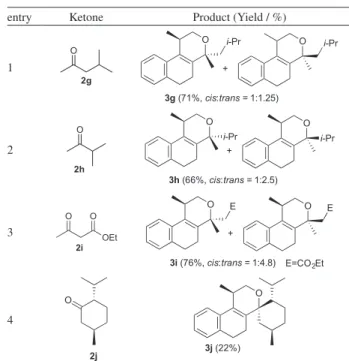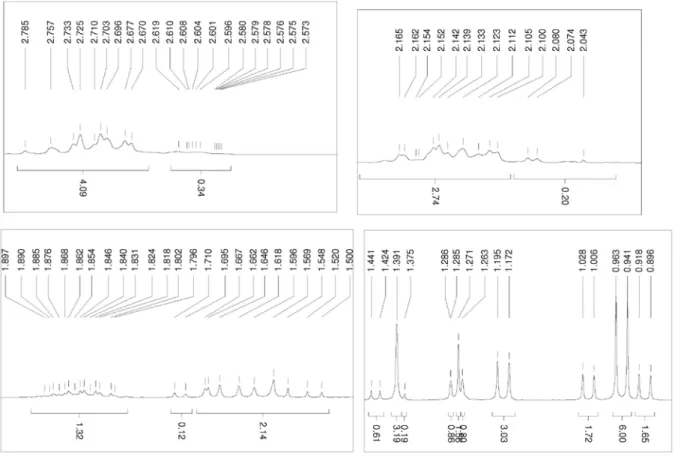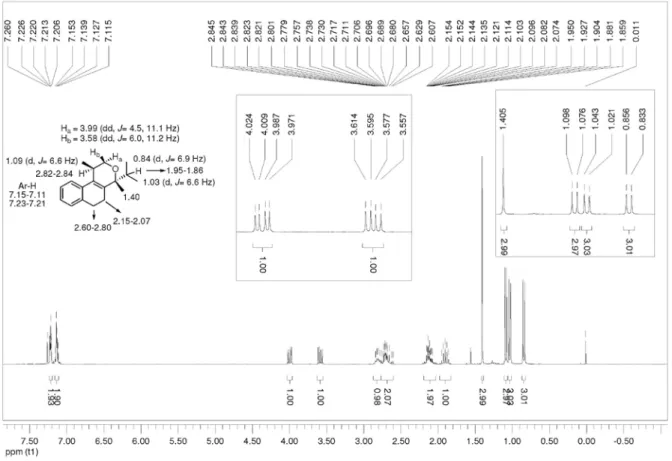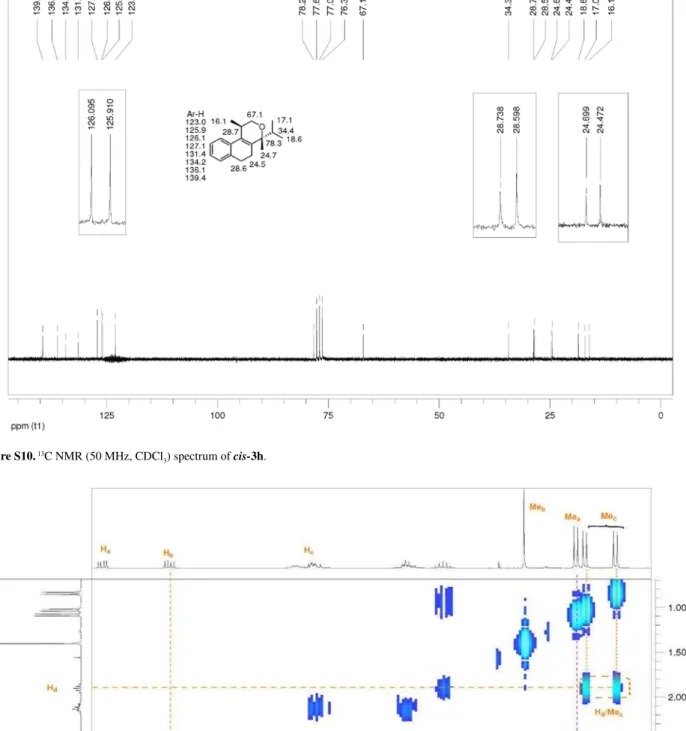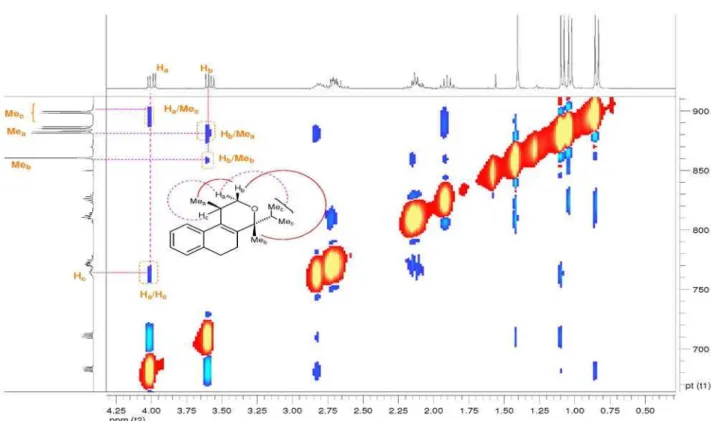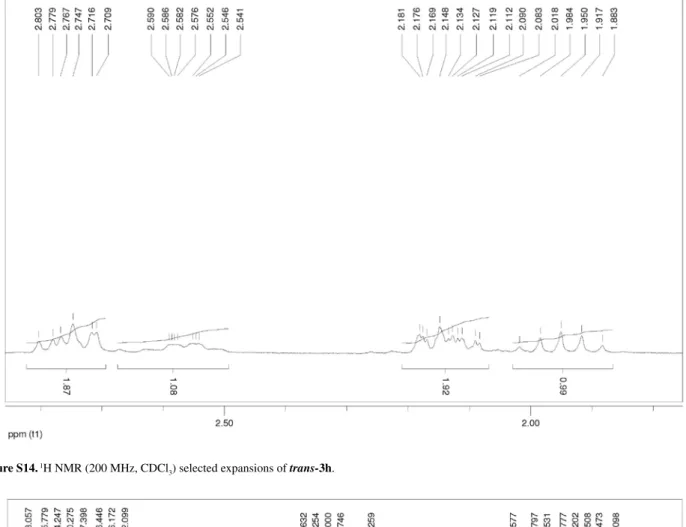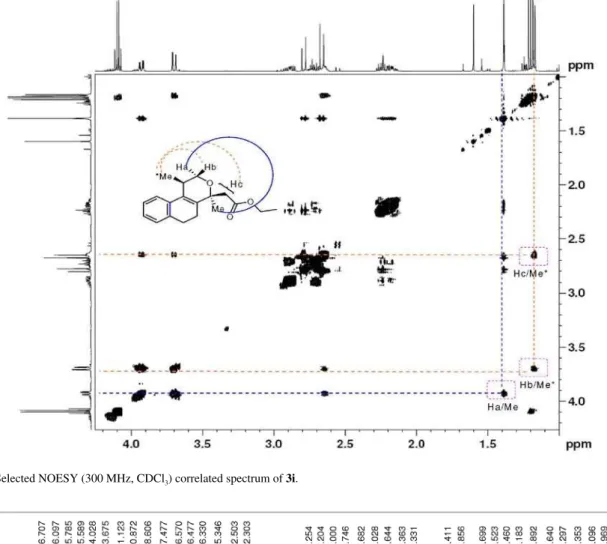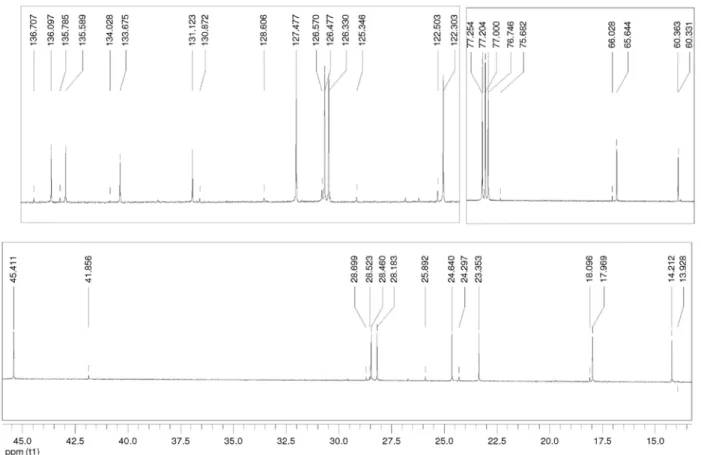Article
J. Braz. Chem. Soc., Vol. 24, No. 9, 1414-1419, 2013. Printed in Brazil - ©2013 Sociedade Brasileira de Química 0103 - 5053 $6.00+0.00
A
http://dx.doi.org/10.5935/0103-5053.20130178*e-mail: luizfsjr@iq.usp.br
Iodine-Catalyzed Prins Cyclization of Aliphatic and Aromatic Ketones
K. R. Kishore K. Reddy and Luiz F. Silva Jr.*
Departamento de Química Fundamental, Instituto de Química, Universidade de São Paulo, Av. Prof. Lineu Prestes, 748, CP 26077, 05513-970 São Paulo-SP, Brazil
A ciclização de Prins catalisada por iodo entre álcoois homoalílicos e cetonas foi investigada. Condições anidras e atmosfera inerte não são necessárias neste protocolo ausente de metais. A reação do 2-(3,4-di-hidronaftalen-1-il)propan-1-ol com seis cetonas simétricas alifáticas levou ao produto desejado em 67-77% de rendimento. A ciclização foi realizada com quatro cetonas alifáticas assimétricas, levando aos correspondentes piranos em 66-76% de rendimento. A ciclização de Prins também foi alcançada com quatro cetonas aromáticas com 37-66% de rendimento. Finalmente, a ciclização de Prins do monoterpeno isopulegol e acetona foi realizada com sucesso.
Iodine-catalyzed Prins cyclization of homoallylic alcohols and ketones was investigated. Anhydrous conditions and inert atmosphere are not required in this metal-free protocol. The reaction of 2-(3,4-dihydronaphthalen-1-yl)propan-1-ol with six aliphatic symmetric ketones gave the desired products in 67-77% yield. Cyclization was performed with four aliphatic unsymmetric ketones, leading to corresponding pyrans in 66-76% yield. Prins cyclization was also accomplished with four aromatic ketones in 37-66% yield. Finally, Prins cyclization of the monoterpene isopulegol and acetone was successfully achieved.
Keywords: iodine, Prins cyclization, ketones, pyrans, spiro compounds
Introduction
Prins cyclization constitutes a powerful tool to obtain tetrahydropyrans (Scheme 1),1-3 including the key step in several total syntheses.4-14 Typically, Prins cyclization is performed mixing a homoallylic alcohol and an aldehyde in the presence of excess of an acid under anhydrous conditions. The use of ketones as the carbonyl components is restricted to a relatively small number of examples.15-22 Additionally, only aliphatic symmetric ketones were usually employed. Herein, we describe the Prins cyclization of homoallylic alcohols 1a-b (Figure 1) with several ketones (aliphatic and aromatic, symmetric and non symmetric) catalyzed by 5 mol% of iodine23,24 without using anhydrous conditions and inert atmosphere.25-27
Results and Discussion
We start our study investigating the reaction of the readily available homoallylic alcohol 1a28 with 1 equiv of acetone (2a) in CH2Cl2. The desired Prins cyclization product 3a was obtained in 76% yield using 5 mol% of iodine (Table 1, entry 1). Under similar conditions, the Prins cyclization could also be performed with 2-pentanone (2b, entry 2), as well as with a series of cyclic ketones (2c-f, entries 3-6).
The next step was the study of unsymmetrical ketones (Table 2). The iodine-catalyzed Prins cyclization of 1a
with ketone 2g gave the chromene derivative 3g in 71% isolated yield, as a 1:1.25 mixture of diastereomers (entry 1). A similar result was obtained using the ketone 2h, although in a slightly higher diastereoselectivity (entry 2).
Figure 1. Structure of Homoallylic Alcohols 1a-b.
Reddy and Silva Jr. 1415 Vol. 24, No. 9, 2013
Ethyl acetoacetate (2i) was also used as the carbonyl component, giving 3i in 75% yield (entry 3). In such a case, the diastereoselectivity was higher than using 2g-h. The reaction of 1a with menthone 2j gave the spirocyclic compound 3j in 22% yield, as a single diastereomer. This low yield is analogous to that previously reported for Prins cyclizations using menthone.22
Considering the results obtained with aliphatic ketones, we tuned our attention to the less reactive aromatic ketones (Table 3). The coupling of acetophenone (2k) and 1a gave
3k, as a 1:5 mixture of diastereomers in 66% yield (entry 1). Using benzophenone (2l) as the carbonyl component, the desired product 3l was isolated in 43% yield (entry 2). The spirocyclic compound 3m was obtained in 52% yield as a single diastereomer, using 1-tetralone (2m), as substrate (entry 3). Chromanone 2n gave the spiro cyclic compound 3n in 37% yield (entry 4).
Based on the results in Tables 1-3, it is possible to conclude that lower yields were observed for the more bulky ketones, either aliphatic (Table 2, entry 4) or aromatic (Table 3, entries 2-4). Additionally, the relative configuration
of the Prins cyclization products (3g-k and 3m-n) shows that the bulkier group is cis to the methyl group. This agrees with the mechanism proposed for the iodine-catalyzed Prins cyclization.25 The relative configurations were assigned by
Table 1. Iodine-catalyzedPrins cyclization of 1a with aliphatic symmetric
ketones 2a-fa
entry Ketone Product (Yield / %)
1 2 3 4 5 6
aConditions: 1a (1.0 equiv), ketone 2a-f (1.0 equiv), I
2 (5 mol%), CH2Cl2.
Table 2. Iodine-Catalyzed Prins cyclization of 1a with aliphatic
unsymmetric ketones 2g-ja
entry Ketone Product (Yield / %)
1
2
3
4
aConditions: 1a (1.0 equiv), ketone 2g-j (1.0 equiv), I
2 (5 mol%), CH2Cl2.
Table 3. Iodine-catalyzed Prins cyclization of 1a with aromatic ketones
2k-2na
entry Ketone Product (Yield / %)
1
2
3
4
aConditions: 1a (1.0 equiv), ketone 2k-n (1.0 equiv), I
Iodine-Catalyzed Prins Cyclization of Aliphatic and Aromatic Ketones J. Braz. Chem. Soc.
1416
nuclear magnetic resonance (NMR) analysis, including Overhauser effect spectroscopy (NOESY) experiments.
The Prins cyclization of the monoterpene isopulegol 1b
was also investigated, because it has very different structural features when compared to 1a. Treatment of a mixture of
1b and acetone (2a) with iodine gave the functionalized bicyclic compound 5, as a single diastereoisomer. It is important to note that in this case the carbocation intermediate 4 reacts with water (formed in situ), instead of losing a proton like in previous cases. The attack of water occurs through the equatorial face, explaining the formation of a single diastereoisomer (Scheme 2).25,29
Conclusions
The iodine-catalyzed Prins cyclization of homoallylic alcohols and several ketones (aliphatic and aromatic, symmetric and unsymmetric) furnishes the desired hydropyrans in good to moderate yield. This protocol can be useful to prepare O-heterocycles under very mild conditions. In the case of hindered ketones, the desired products were obtained in lower yield.
Experimental
All commercially available reagents were used without further purification unless otherwise noted. Commercially available isopulegol was purified by flash column chromatography (15% AcOEt in hexanes). Tetrahydrofuran (THF) and benzene were freshly distilled from sodium/ benzophenone. CH2Cl2 was freshly distilled over CaH2. Thin layer chromatography (TLC) analyses were performed in silica gel plates, using UV and/or p-anisaldehyde solution for visualization. Flash column chromatography was performed using silica gel 200-400 mesh. Melting points are uncorrected. All NMR analyses were recorded using CDCl3 as solvent and tetramethylsilane (TMS) as internal pattern. The experimental procedures for the preparation of compounds 3a and 3c-e were previously reported.25
4,4-Diethyl-1-methyl-1,4,5,6-tetrahydro-2H-benzo[f] isochromene (3b). General procedure for iodine-catalyzed prins cyclization: I2 (0.030, 0.076 mmol) was added to a stirred solution of 1a (0.113 g, 0.600 mmol) and 2b
(0.06 mL, 0.6 mmol) in CH2Cl2 (5 mL). The mixture was refluxed for 3 h. Na2SO3 (0.0075 g, 0.60 mmol) and H2O
(10 mL) were added. The aqueous phase was extracted with AcOEt (3 × 5 mL). The combined organic phase was washed with brine (5 mL) and dried over anhydrous MgSO4. The solvent was removed under reduced pressure. The crude product was purified by flash column chromatography (5% AcOEt in hexanes), affording 3b
(0.115 g, 0.450 mmol, 75%) as white solid; mp 58-60 oC; Rf = 0.56 (hexanes:EtOAc, 9:1); IR (film) ν/cm
-1 3061,
2963, 2930, 1487, 1452, 765, 733; 1H NMR (200 MHz, CDCl3) d 0.91 (t, J 7.4 Hz, 3H), 1.25 (d, J 6.8 Hz, 3H), 1.47-1.62 (m, 2H), 1.71-1.85 (m, 2H), 2.06-2.13 (m, 2H), 2.56-2.64 (m, 1H), 2.69-2.79 (m, 2H), 3.62 (dd, J 11.2, 1.7 Hz, 1H), 3.90 (dd, J 11.1, 3.2 Hz, 1H), 7.10-7.14 (m, 2H), 7.16-7.28 (m, 2H); 13C NMR (50 MHz, CDCl
3) d 7.4, 8.7, 18.6, 24.1, 28.0, 28.5, 28.6, 28.7, 65.3, 79.6, 122.2, 126.2, 126.4, 127.4, 131.4, 134.1, 136.0, 136.9; LRMS m/z (rel. int.)256 (M+•, 0.32), 228 (10), 227 (100); HRMS [ESI(+)]
calcd. for [C18H24O + Na]
+ 279.1725, found 279.1718.
1-Methyl-1,2,5,6-tetrahydrospiro[benzo[f ]isochromene-4,1’-cyclododecane] (3f): the reaction was performed following the general procedure, but using 1a (0.113 g, 0.600 mmol), 2f (0.110 g, 0.600 mmol), CH2Cl2 (5 mL) and I2 (0.0076, 0.030 mmol). Compound 3f (0.148 g, 0.420 mmol, 70%) was obtained as colorless oil;Rf = 0.76 (hexanes-EtOAc, 9.5:0.5);IR (film) ν/cm-1 3063, 2926,
2932, 2861, 1469, 765, 733;1H NMR (200 MHz,CDCl 3) d 1.21 (d, J 6.8 Hz, 3H), 1.40-1.47 (m, 18H), 1.69-1.79 (m, 4H), 2.06-2.31 (m, 2H), 2.62-2.70 (m, 3H), 3.59 (dd, J 2.4, 11.0 Hz, 1H), 3.87 (dd, J 3.3, 11.1 Hz, 1H), 7.09-7.28 (m, 4H); 13C NMR (50 MHz, CDCl
3) d 18.3, 20.2, 21.1, 22.8, 23.0, 23.3, 23.6, 24.7, 25.7, 27.0, 27.1, 28.7, 29.1, 31.6, 35.8, 65.2, 78.6, 122.4, 126.0, 126.3, 127.2, 130.0, 134.3, 136.0,139.5;LRMS m/z (rel. int.) 352 (M+•
, 27.0), 337 (7.3), 309 (4.36), 281 (6.0), 226 (16.8), 225 (100);HRMS [ESI(+)] calcd. for [C25H36O + H]
+ 353.2839, found 353.2841.
2,4,5,6-Tetrahydro-4-isobutyl-1,4-dimethyl-1H-benzo[f] isochromene (3g):the reaction was performed following the general procedure, but using 1a (0.090 g, 0.48 mmol),
2g (0.060 mL, 0.48 mmol), CH2Cl2 (5 mL) and I2 (0.0061 g, 0.024 mmol). Compound 3g (1:1.25 cis:trans, 0.092 g, 0.34 mmol, 71%) was obtained as a pale yellow oil; Rf = 0.63 (hexanes-EtOAc, 9:1); IR (film) ν/cm
-1
3061, 2950, 2928, 1488, 1451, 1126, 766, 735;1H NMR (300 MHz, CDCl3) dtrans-3g 0.95 (d, J 6.6 Hz, 6H), 1.18 (d, J 6.9 Hz, 3H), 1.39 (s, 3H), 1.42-1.71 (m, 2H), 1.80-1.90 (m, 1H), 2.04-2.16 (m, 2H), 2.67-2.78 (m, 3H), 3.58 (dd,
J 11.1, 3.3 Hz, 1H), 3.91 (dd, J 11.4, 3.6 Hz, 1H), 7.11-7.13 (m, 2H), 7.15-7.29 (m, 2H); cis-3g 9.07 (d, J 6.6 Hz, 3H), 1.02 (d, J 6.6 Hz, 3H), 1.271 (s, 3H), 1.274 (d, J 6.9 Hz,
Reddy and Silva Jr. 1417 Vol. 24, No. 9, 2013
3H), 3.65 (dd, J 11.1, 1.5 Hz, 1H), 3.94 (dd, J 11.4, 3.0 Hz, 1H). Other signals overlap with the major diastereomer; 13C NMR (50 MHz, CDCl
3) dtrans-3g 18.0, 24.0, 24.1, 24.2, 24.8, 25.2, 28.8, 43.9, 65.6, 77.2, 122.5, 126.1, 126.3, 127.3, 130.1, 134.1, 136.0, 139.4; cis-3g 18.5, 24.1, 24.4, 24.7, 25.1, 25.6, 28.3, 48.4, 65.4, 78.1, 122.2, 126.2, 126.4, 127.4, 130.7, 135.7, 137.5 ; LRMS m/z (rel. int.) 270 (M+•,
2.03), 255 (20), 214 (17), 213 (100);HRMS [ESI(+)] calcd. for [C19H26O + H]+ 271.2062, found 271.2053.
2 , 4 , 5 , 6 Te t r a hy d r o 4 i s o p r o py l 1 , 4 d i m e t hy l -1H-benzo[f]isochromene (3h):the reaction was performed following the general procedure, but using 1a (0.113 g, 0.600 mmol), 2h (0.064 mL, 0.60 mmol), CH2Cl2 (5 mL) and I2 (0.0076, 0.030 mmol). Compound cis-3h (0.0271, 0.106 mmol, 18%) and trans-3h (0.0675 g, 0.264 mmol, 44%) were obtained as white solid and colorless viscous oil, respectively. (±)-(1R,4R )-2,4,5,6-tetrahydro-4-isopropyl-1,4-dimethyl-1H-benzo[f]isochromene (cis-3h); mp 61-63 °C; Rf = 0.34 (hexanes-EtOAc,
9.5:0.5); IR (film) ν/cm-1 3060, 2967, 2934, 1451, 766;
1H NMR (300 MHz, CDCl
3) d 0.84 (d, J 6.9 Hz, 3H), 1.03 (d, J 6.6 Hz, 3H), 1.09 (d, J 6.6 Hz, 3H), 1.40 (s, 3H), 1.86-1.95 (m, 1H), 2.07-2.15 (m, 2H), 2.61-2.80 (m, 2H), 2.82-2.84 (m, 1H), 3.58 (dd, J 11.2, 6.0 Hz, 1H), 3.99 (dd,
J 11.1, 4.5 Hz, 1H), 7.11-7.15 (2H), 7.22-7.23 (m, 2H); 13C NMR (50 MHz, CDCl
3) d 16.1, 17.1, 18.6, 24.5, 24.7, 28.6, 28.7, 34.4, 67.1, 78.3, 123.0, 125.9, 126.1, 127.1, 131.4, 134.2, 136.1, 139.4; LRMS m/z (rel. int.)256 (M+•,
0.08), 241 (0.87), 213 (100); HRMS [ESI(+)] calcd. for [C18H25O + H]+ 257.1900, found 257.1899. (±)-(1R,4S )-2,4,5,6-tetrahydro-4-isopropyl-1,4-dimethyl-1H-benzo[f] isochromen (trans-3h); Rf = 0.31 (hexanes-EtOAc, 9.5:0.5); IR (film) ν/cm-1 3061, 2964, 2931, 1451, 766;
1H NMR (300MHz, CDCl
3) d 0.92 (d, J 6.8 Hz, 3H), 1.04 (d, J 6.8 Hz, 3H), 1.28 (d, J 7.0 Hz, 3H), 1.30 (s, 3H), 1.88-2.02 (m, 1H), 2.08-2.18 (m, 2H), 2.54-2.59 (m, 1H), 2.71-2.80 (m, 2H), 3.66 (dd, J 0.8, 11.0 Hz, 1H), 3.90 (dd,
J 3.1, 11.1 Hz, 1H), 7.10-7.13 (m, 2H), 7.17-7.30 (m, 2H); 13C NMR (75 MHz, CDCl
3) d 16.1, 18.47, 18.51, 21.2, 23.8, 28.5, 28.8, 34.6, 65.3, 78.6, 122.1, 126.2, 126.4, 127.4, 130.3, 134.2, 135.8, 138.1; LRMS m/z (rel. int.) 256 (M+•, 0.5), 241 (4.1), 213 (100); HRMS [ESI(+)]
calcd. for [C18H24O + Na]
+ 279.1719, found 279.1679.
Ethyl 2-(2,4,5,6-tetrahydro-1,4-dimethyl-1H-benzo[f] isochromen-4-yl)acetate (3i):the reaction was performed following the general procedure, but using 1a (0.89 g, 0.47 mmol), 2i (0.060 mL, 0.47 mmol), CH2Cl2 (5 mL) and I2 (0.0060, 0.024 mmol). Compound 3i (1:4.8, cis:trans 0.108 g, 0.36 mmol, 76%) was obtained as colorless viscous
oil; Rf = 0.26 ((hexanes-EtOAc, 9:1);IR (film) ν/cm-1
3060, 2975, 2932, 2900, 2870, 1732, 1488, 1463, 1450, 1034, 1060, 1075, 768, 735.1H NMR (300 MHz, CDCl
3)
dtrans-3i 1.75 (d, J 4.2 Hz, 3H), 1.20 (t, J 4.2 Hz, 3H), 1.39 (s, 3H), 2.13-2.28 (m, 2H), 2.63-2.66 (m, 1H), 2.66 (d, J 7.8 Hz, 1H), 2.69-2.74 (m, 1H), 2.79 (d, J 8.1 Hz, 3H), 2.85-2.94 (m, 1H), 3.70 (dd, J 6.75, 1.0 Hz, 1H), 3.92 (dd, J 6.9, 1.8 Hz, 3H), 4.09 (q, J 4.2 Hz, 2H), 7.12-7.13 (m, 2H), 7.18-7.22 (m, 1H), 7.24 (br, 1H). cis-3i 1.23 (d,
J 3.9 Hz, 3H), 1.24 (d, J 4.2 Hz, 3H), 1.54 (s, 3H), 4.15 (d, J 4.2 Hz, 2H) 7.14 -7.15 (m, 2H). Other signals overlap with the major diastereomer;13C NMR (50 MHz, CDCl
3)
d trans-3i 14.2, 18.0, 23.3, 24.6, 28.1, 28.5, 45.4, 45.4, 60.3, 65.6, 77.2, 122.3, 126.3, 126.5, 127.5, 131.1, 133.7, 135.6, 136.1, 170.2, cis-3i 13.9, 18.1, 24.3, 25.9, 28.5, 28.7, 41.8, 60.4, 66.0, 75.7, 122.5, 125.4, 126.6, 128.6, 130.9, 134.0, 135.8, 136.7, 170.5;LRMS m/z (rel. int.)300 (M+•,
2.3), 213 (60.8), 165 (16.0), 153 (17.4), 141 (23.0), 128 (22.5), 115 (19.9), 43 (100); HRMS [ESI(+)] calcd. for [C19H24O3+Na]
+ 323.1623, found.323.1625.
(1R,2’R,5’R
)-2’-isopropyl-1,5-diMethyl-1,2,5,6-etrahydrospiro[benzo[f]issochrom-ene-4,1’cyclohexane] (3j): the reaction was performed following the general procedure, but using 1a (0.113 g, 0.600 mmol), 2j (0.103 mL, 0.600 mmol), CH2Cl2 (5 mL) and I2 (0.0076, 0.030 mmol). Compound 3j (0.0429 g, 0.132 mmol, 22%) was obtained as colorless oil; Rf = 0.41 (hexanes-EtOAc, 9.5:0.5); IR (film) ν/cm-1 3061, 3030, 2936, 2924, 2856, 1453, 1090, 748, 699;
1H NMR (300 MHz, CDCl
3) d0.77 (d, J 7.2 Hz, 3H), 0.85 (d, J 6.8 Hz, 3H), 0.90 (d, J 6.4 Hz, 3H), 0.99 (d, J 6.8 Hz, 3H), 1.13-1.29 (m, 2H), 1.32-1.37 (m, 1H), 1.42-1.68 (m, 4H), 1.75-1.82 (m, 2H), 1.91-2.05 (m, 2H), 2.12-2.20 (m, 1H), 2.55-2.73 (m, 2H), 2.90-2.97 (m, 1H), 3.48 (dd, J 11.4, 8.4 Hz, 1H), 3.92 (dd, J 11.4, 5.7 Hz, 1H), 7.12-7.15 (m, 2H), 7.21-7.23 (m, 2H); 13C NMR (50 MHz, CDCl
3) d 16.8, 18.7, 20.5, 22.5, 24.0, 24.7, 27.2, 27.5, 28.3, 28.8, 35.3, 42.4, 46.1, 65.5, 80.0, 123.5, 125.7, 125.9, 127.0, 132.4, 134.5, 136.4, 140.2; LRMS m/z (rel. int.)324 (M+•, 10), 309 (3.37), 240
(17), 239 (100); HRMS [ESI(+)] calcd. for [C23H32O + H] +
325.2526, found 325.2532.
1,4-Dimethyl-4-phenyl-1,4,5,6-tetrahydro-2H-benzo[f]
isochromene (3k):the reaction was performed following the general procedure, but using 1a (0.113 g, 0.600 mmol),
)-Iodine-Catalyzed Prins Cyclization of Aliphatic and Aromatic Ketones J. Braz. Chem. Soc.
1418
1,4-dimethyl-4-phenyl-1,4,5,6-tetrahydro-2H-benzo[f] isochromene (cis-3k); mp 98-100 °C; R
f = 0.38
(hexanes-EtOAc, 9.5:0.5); IR (film) ν/cm-1 3059, 2929, 2247, 1489,
764, 699; 1H NMR (200 MHz, CDCl
3) d 1.35 (d, J 6.8 Hz, 3H), 1.80 (s, 3H), 1.94-2.10 (m, 1H), 2.19-2.35 (m, 1H), 2.65-2.70 (m, 1H), 2.74-2.96 (m, 2H), 3.47 (dd, J 1.8, 11.2 Hz, 1H), 3.70 (dd, J 3.0, 11.2 Hz, 1H), 7.15-7.17 (m, 2H), 7.23-7.38 (m, 5H), 7.49-7.54 (m, 2H); 13C NMR (50 MHz, CDCl3) d 18.8, 25.6, 26.1, 28.3, 29.1, 65.3, 78.1, 122.6, 126.5, 126.6, 127.2, 127.47. 127.55, 128.0, 132.2, 133.9, 135.8, 135.9, 143.0; LRMS m/z (rel. int.) 290 (M+•
), 275 (87), 77 (100); HRMS [ESI(+)] calcd. for [C21H22O + Na]+ 313.1563, found 313.1559. (±)-(1R,4S )-2,4,5,6-tetrahydro-1,4-dimethyl-4-phenyl-1H-benzo[f] isochromene (trans-3k); Rf = 0.41 (hexanes-EtOAc, 9.5-0.5); IR (film) ν/cm-1 3069, 2930, 2244, 1489, 766,
700; 1H NMR (200 MHz, CDCl
3) d 1.23 (d, J 7.0 Hz, 3H), 1.71 (s, 3H), 1.80-1.94 (m, 1H), 2.05-2.28 (m, 1H), 2.61-2.72 (m, 2H), 2.85-2.96 (m, 1H), 3.51 (dd, J 4.7, 11.5 Hz, 1H), 4.02 (dd, J 4.5, 11.5 Hz, 1H), 7.12-7.19 (m, 2H), 7.28-7.40 (m, 5H), 7.56-7.61 (m, 2H); 13C NMR (50 MHz, CDCl3) d 17.8, 22.3, 25.3, 28.2, 28.4, 66.3, 79.0, 126.3, 126.4, 127.2, 127.46, 127.53, 128.1, 131.4, 133.8, 136.1, 137.5, 144.5; LRMS m/z (rel. int.) 290 (M+•
, 19), 275 (100); HRMS [ESI(+)] calcd. for [C21H23O + H]+ 291.1743, found 291.1755.
1-Methyl-4,4’-diphenyl-2,4,5,6-tetrahydro-1H-benzo[f] isochromene (3l):the reaction was performed following the general procedure, but using 1a (0.113 g, 0.600 mmol),
2l (0.109 g, 0.60 mmol), CH2Cl2 (5 mL) and I2 (0.0076, 0.030 mmol). The crude product was purified by flash column chromatography (5% AcOEt in hexanes). Compound
3l (0.0925 g, 0.258 mmol, 43%)was obtained as colorless viscous oil;Rf = 0.71 (hexanes-EtOAc, 1:9);IR (film) ν/
cm-1 3059, 3023, 2957, 2870, 2246, 1488, 1447, 761, 732, 700;1H NMR (200 MHz, CDCl
3) d 1.34 (d, J 6.6 Hz, 3H), 1.86-1.94 (m, 2H), 2.61-2.70 (m, 2H), 2.86-2.95 (m, 1H), 3.47 (dd, J 4.8, 11.4 Hz, 1H), 3.81 (dd, J 11.6, 4.4 Hz, 1H), 7.10-7.47 (m, 14H);13C NMR (50 MHz, CDCl
3) d 18.6, 26.8, 28.2, 28.7, 66.1, 85.0, 123.1, 126.3, 126.6, 127.4, 127.5, 127.60, 127.62, 129.2, 129.4, 132.8, 134.0, 135.7, 136.1, 143.3, 144.2;LRMS m/z (rel. int.)352 (M+•, 9), 310
(61), 288 (16), 275 (53), 105 (63), 77 (100);HRMS [ESI(+)] calcd. for [C26H24O + H]+ 353.1900, found 353.1884.
(1R,1’S)-1-methyl-1,2,3’,4’,5,6-hexahydro-2’H
-spiro[benzo[f]isochromene-4,1’-napthalene] (3m): the reaction was performed following the general procedure, but using 1a (0.113 g, 0.600 mmol), 2m (0.080 mL, 0.60 mmol), CH2Cl2 (5 mL) and I2 (0.0076, 0.030 mmol).
Compound 3m (0.0998 g, 0.312 mmol, 52%) was obtained as colorless viscous oil;Rf = 0.63 (hexanes-EtOAc, 9:1);
IR (film) ν/cm-1 3061, 3017, 2928, 2868, 2244, 1487, 1450,
762, 730;1H NMR (300 MHz, CDCl
3) d 1.33 (d, J 6.9 Hz, 3H), 1.75-1.90 (m, 2H), 2.01-2.11 (m, 3H), 2.20-2.36 (m, 1H), 2.64-2.72 (m, 2H), 2.76-2.96 (m, 3H), 3.56 (dd, J 2.7, 11.4 Hz, 1H), 4.00 (dd, J 3.3, 11.4 Hz, 1H), 7.06-7.29 (m, 6H), 7.32-7.38 (m, 2H);13C NMR (50 MHz, CDCl
3) d 18.3, 18.7, 25.5, 28.4, 29.1, 29.7, 34.6, 64.8, 75.8, 122.5, 125.3, 126.4, 126.5, 127.5, 127.6, 128.2, 129.6, 132.9, 134.1, 136.1, 136.4, 137.4, 137.8;LRMS m/z (rel. int.)316 (M+•,
75), 301 (3.89), 288 (16), 287 (30), 274 (28), 273 (100); HRMS [ESI(+)] calcd. for [C23H24O + H]+ 317.1900, found 317.1902.
(1R,4S)-1-methyl-1,2,5,6-tetrahydrospiro[benzo[f] isochromene-4,4’-chroman] (3n): the reaction was performed following the general procedure, but using
1a (0.113 g, 0.600 mmol), 2n (0.089 g, 0.60 mmol) CH2Cl2 (5 mL) and I2 (0.0076, 0.030 mmol). Compound
3n (0.071 g, 0.22 mmol, 37%) was obtained as colorless viscous oil; Rf = 0.64 (hexanes-EtOAc, 9:1); IR (film) ν/cm-1 3064, 3029, 2928, 2948, 1484, 1447, 766, 731;
1H NMR (300 MHz, CDCl
3) d 1.35 (d, J 6.6 Hz, 3H), 1.72-2.14 (m, 3H), 2.32-2.48 (m, 1H), 2.32-2.48 (m, 1H), 2.64-2.75 (m, 2H), 2.78-2.84 (m, 1H), 3.60 (dd, J 1.8, 11.2 Hz, 1H), 4.06 (dd, J 3.0, 11.2 Hz, 1H), 4.29-4.38 (m, 1H), 4.50-4.63 (m, 1H), 6.77-6.90 (1H), 7.14-7.30 (m, 5H), 7.38 (d, J 7.4 Hz, 1H);13C NMR (50 MHz, CDCl
3) d 18.9, 24.8, 28.4, 29.2, 33.2, 62.1, 64.8, 72.1, 117.3, 119.6, 122.5, 123.5, 126.5, 126.8, 127.6, 128.8, 129.5, 133.8, 134.0, 134.2, 136.0, 155.0;LRMS m/z (rel. int.)316 (M+•
, 75), 290 (35), 289 (80), 273 (68), 247 (39), 231 (53, 32 (100);HRMS [ESI(+)] calcd. for [C22H22O2+Na]
+ 341.1512,
found 341.1516.
(+)-(4S,4aS,7R,8aS
)-2,2,4,7-tetramethyloctahydro-2H-chromen-4-ol (5):the reaction was performed following
the general procedure, but using 1b (0.154 g, 1.00 mmol), acetone (0.089 mL, 1.2 mmol), CH2Cl2 (5 mL) and I2 (0.013, 0.050 mmol). Compound 5 (0.103 g, 0.486 mmol, 49%) was obtained as a white solid; mp 105-106 oC; [α]
D20 5.8 (c 1.00, CHCl3); Rf = 0.12 (hexanes:EtOAc,
9:1);IR (film) ν/cm-1 3465, 3004, 2933, 2883, 1375, 1159;
1H NMR (200 MHz, CDCl
3) d 0.93 (d, J 6.6 Hz, 3H), 1.01-1.13 (m, 5H), 1.18 (s, 6H), 1.39 (s, 3H), 1.47 (br, 1H), 1.54 (br, 1H), 1.60 (br, 1H), 1.67-1.94 (m, 3H), 3.51-3.64 (m, 1H);13C NMR (50 MHz, CDCl
Reddy and Silva Jr. 1419 Vol. 24, No. 9, 2013
71 (35), 67 (47.7), 59 (69.2), 55 (100);HRMS [ESI(+)] calcd. for [C13H24O2 + H]
+ 213.1849, found 213.1854.
Supplementary Information
NMR copies are available free of charge at http://jbcs. sbq.org.br as a PDF file.
Acknowledgments
The authors wish to thank FAPESP, CNPq and CAPES for financial support. The authors also wish to thank Dr. S. A. P. Quintiliano for initial experiments.
References
1. Olier, C.; Kaafarani, M.; Gastaldi, S.; Bertrand, M. P.;
Tetrahedron2010, 66, 413.
2. Crane, E. A.; Scheidt, K. A.; Angew. Chem., Int. Ed.2010, 49, 8316.
3. Vasconcellos, M.; Miranda, L. S. M.; Quim. Nova2006, 29, 834.
4. Marumoto, S.; Jaber, J. J.; Vitale, J. P.; Rychnovsky, S. D.; Org. Lett.2002, 4, 3919.
5. Kopecky, D. J.; Rychnovsky, S. D.; J. Am. Chem. Soc.2001,
123, 8420.
6. Aubele, D. L.; Wan, S. Y.; Floreancig, P. E.; Angew. Chem., Int. Ed.2005, 44, 3485.
7. Vintonyak, V. V.; Kunze, B.; Sasse, F.; Maier, M. E.; Chem. Eur. J. 2008, 14, 11132.
8. Seden, P. T.; Charmant, J. P. H.; Willis, C. L.; Org. Lett.2008,
10, 1637.
9. Woo, S. K.; Kwon, M. S.; Lee, E.; Angew. Chem., Int. Ed.2008,
47, 3242.
10. Custar, D. W.; Zabawa, T. P.; Scheidt, K. A.; J. Am. Chem. Soc.
2008, 130, 804.
11. Sabitha, G.; Fatima, N.; Gopal, P.; Reddy, C. N.; Yadav, J. S.;
Tetrahedron: Asymmetry2009, 20, 184.
12. Woo, S. K.; Lee, E.; J. Am. Chem. Soc.2010, 132, 4564. 13. Yadav, J. S.; Pattanayak, M. R.; Das, P. P.; Mohapatra, D. K.;
Org. Lett.2011, 13, 1710.
14. Crane, E. A.; Zabawa, T. P.; Farmer, R. L.; Scheidt, K. A.;
Angew. Chem., Int. Ed.2011, 50, 9112.
15. Nishizawa, M.; Shigaraki, T.; Takao, H.; Imagawa, H.; Sugihara, A.; Tetrahedron Lett.1999, 40, 1153.
16. Aubele, D. L.; Lee, C. A.; Floreancig, P. E.; Org. Lett.2003, 5, 4521.
17. Cossey, K. N.; Funk, R. L.; J. Am. Chem. Soc.2004, 126, 12216. 18. Yadav, J. S.; Reddy, B. V. S.; Krishna, V. H.; Swamy, T.;
Kumar, G.; Can. J. Chem.2007, 85, 412.
19. Yadav, J. S.; Reddy, B. V. S.; Yadav, N. N.; Satheesh, G.;
Synthesis2008, 2733.
20 Yadav, J. S.; Reddy, B. V. S.; Kumar, G.; Aravind, S.; Synthesis
2008, 395.
21. Kishi, Y.; Inagi, S.; Fuchigami, T.; Eur. J. Org. Chem.2009, 103.
22. Jacolot, M.; Jean, M.; Levoin, N.; van de Weghe, P.; Org. Lett.
2012, 14, 58.
23. Kupper, F. C.; Feiters, M. C.; Olofsson, B.; Kaiho, T.; Yanagida, S.; Zimmermann, M. B.; Carpenter, L. J.; Luther III, G. W.; Lu, Z.; Jonsson, M.; Kloo, L.; Angew. Chem., Int. Ed.
2011, 50, 11598.
24. Yadav, J. S.; Reddy, B. V. S.; Kumar, G.; Swamy, T.; Tetrahedron Lett.2007, 48, 2205.
25. For a preliminary communication, see: Silva Jr., L. F.; Quintiliano, S. A.; Tetrahedron Lett.2009, 50, 2256.
26. Reddy, K. R. K. K.; Longato, G. B.; de Carvalho, J. E.; Ruiz, A. L. T. G.; Silva Jr., L. F.; Molecules2012, 17, 9621. 27. Figueiredo, C. A. M.; Reddy, K. R. K. K.; Monteiro, P. A.;
de Carvalho, J. E.; Ruiz, A. L. T. G.; Silva Jr., L. F.; Synthesis
2013, 45, 1076.
28. Ferraz, H. M. C.; Silva Jr., L. F.; Tetrahedron 2001, 57, 9939. 29. Alder, R. W.; Harvey, J. N.; Oakley, M. T.; J. Am. Chem. Soc.
2002, 124, 4960.
Submitted: May 5, 2013 Published online: August 6, 2013
Supplementary Information
S
I
J. Braz. Chem. Soc., Vol. 24, No. 9, S1-S22, 2013. Printed in Brazil - ©2013 Sociedade Brasileira de Química 0103 - 5053 $6.00+0.00
*e-mail: luizfsjr@iq.usp.br
Iodine-Catalyzed Prins Cyclization of Aliphatic and Aromatic Ketones
K. R. Kishore K. Reddy and Luiz F. Silva Jr.*
Departamento de Química Fundamental, Instituto de Química, Universidade de São Paulo, Av. Prof. Lineu Prestes, 748, CP 26077, 05513-970 São Paulo-SP, Brazil
Figure S1. 1H NMR (200 MHz, CDCl
Iodine-Catalyzed Prins Cyclization of Aliphatic and Aromatic Ketones J. Braz. Chem. Soc.
S2
Figure S2. 13C NMR (75 MHz, CDCl
3) spectrum of 3b.
Figure S3. 1H NMR (200 MHz, CDCl
Reddy and Silva Jr. S3 Vol. 24, No. 9, 2013
Figure S4. 13C NMR (50 MHz, CDCl
3) spectrum of 3f.
Figure S5. 1H NMR (300 MHz, CDCl
Iodine-Catalyzed Prins Cyclization of Aliphatic and Aromatic Ketones J. Braz. Chem. Soc.
S4
Figure S6. 1H NMR (300 MHz, CDCl
3) selected expansions of 3g.
Figure S7. 13C NMR (75 MHz, CDCl
Reddy and Silva Jr. S5 Vol. 24, No. 9, 2013
Figure S8. 1H NMR (300 MHz, CDCl
3) spectrum of cis-3h.
Figure S9. 1H NMR (200 MHz, CDCl
Iodine-Catalyzed Prins Cyclization of Aliphatic and Aromatic Ketones J. Braz. Chem. Soc.
S6
Figure S10. 13C NMR (50 MHz, CDCl
3) spectrum of cis-3h.
Reddy and Silva Jr. S7 Vol. 24, No. 9, 2013
Figure S12.Selected NOESY (300 MHz, CDCl3) correlated spectrum of cis-3h.
Figure S13. 1H NMR (200 MHz, CDCl
Iodine-Catalyzed Prins Cyclization of Aliphatic and Aromatic Ketones J. Braz. Chem. Soc.
S8
Figure S14. 1H NMR (200 MHz, CDCl
3) selected expansions of trans-3h.
Figure S15. 13C NMR (75 MHz, CDCl
Reddy and Silva Jr. S9 Vol. 24, No. 9, 2013
Figure S16.Selected COSY (300 MHz, CDCl3) correlated spectrum of trans-3h.
Iodine-Catalyzed Prins Cyclization of Aliphatic and Aromatic Ketones J. Braz. Chem. Soc.
S10
Figure S18. 1H NMR (300 MHz, CDCl
3) spectrum of 3i.
Figure S19. 1H NMR (300 MHz, CDCl
Reddy and Silva Jr. S11 Vol. 24, No. 9, 2013
Figure S20.Selected NOESY (300 MHz, CDCl3) correlated spectrum of 3i.
Figure S21. 13C NMR (75 MHz, CDCl
Iodine-Catalyzed Prins Cyclization of Aliphatic and Aromatic Ketones J. Braz. Chem. Soc.
S12
Figure S22. 13C NMR (75 MHz, CDCl
3) selected expansions of 3i.
Figure S23. 1H NMR (200 MHz, CDCl
Reddy and Silva Jr. S13 Vol. 24, No. 9, 2013
Figure S24. 13C NMR (75 MHz, CDCl
3) spectrum of 3j.
Figure S25. 1H NMR (200 MHz, CDCl
Iodine-Catalyzed Prins Cyclization of Aliphatic and Aromatic Ketones J. Braz. Chem. Soc.
S14
Figure S26. 1H NMR (200 MHz, CDCl
3) selected expansion of cis-3k.
Figure S27. 13C NMR (75 MHz, CDCl
Reddy and Silva Jr. S15 Vol. 24, No. 9, 2013
Figure S28.Selected NOESY (300 MHz, CDCl3) correlated spectrum of cis-3k.
Figure S29. 1H NMR (200 MHz, CDCl
Iodine-Catalyzed Prins Cyclization of Aliphatic and Aromatic Ketones J. Braz. Chem. Soc.
S16
Figure S30. 1H NMR (200 MHz, CDCl
3) selected expansion of trans-3k.
Figure S31. 13C NMR (75 MHz, CDCl
Reddy and Silva Jr. S17 Vol. 24, No. 9, 2013
Figure S32. 1H NMR (200 MHz, CDCl
3) spectrum of 3l.
Figure S33. 1H NMR (50 MHz, CDCl
Iodine-Catalyzed Prins Cyclization of Aliphatic and Aromatic Ketones J. Braz. Chem. Soc.
S18
Figure S34. 1H NMR (300 MHz, CDCl
3) spectrum of 3m.
Figure S35. 1H NMR (300 MHz, CDCl
Reddy and Silva Jr. S19 Vol. 24, No. 9, 2013
Figure S36. 13C NMR (50 MHz, CDCl
3) spectrum of 3m.
Figure S37. 1H NMR (200 MHz, CDCl
Iodine-Catalyzed Prins Cyclization of Aliphatic and Aromatic Ketones J. Braz. Chem. Soc.
S20
Figure S38. 1H NMR (200 MHz, CDCl
3) selected expansions of 3n.
Figure S39. 13C NMR (50 MHz, CDCl
Reddy and Silva Jr. S21 Vol. 24, No. 9, 2013
Figure S40. 1H NMR (200 MHz, CDCl
3) spectrum of (+)-5.
Figure S41. 1H NMR (200 MHz, CDCl
Iodine-Catalyzed Prins Cyclization of Aliphatic and Aromatic Ketones J. Braz. Chem. Soc.
S22
Figure S42.NOESY (300 MHz, CDCl3) correlated spectrum of (+)-5.
Figure S43. 13C NMR (50 MHz, CDCl
